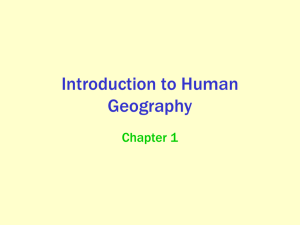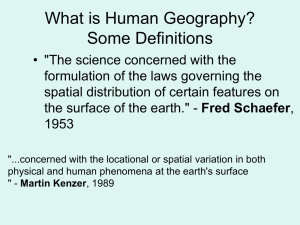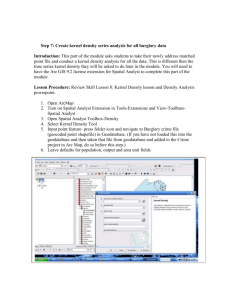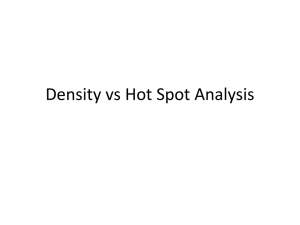The tail of the spatial kernel and its implications for biological
advertisement
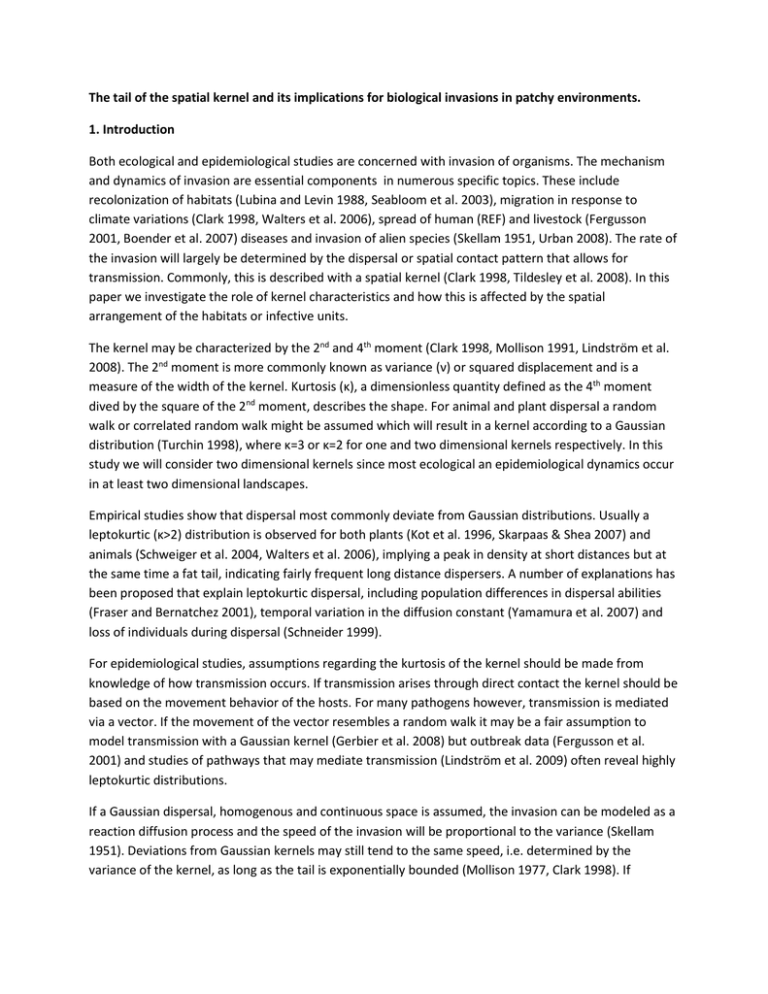
The tail of the spatial kernel and its implications for biological invasions in patchy environments. 1. Introduction Both ecological and epidemiological studies are concerned with invasion of organisms. The mechanism and dynamics of invasion are essential components in numerous specific topics. These include recolonization of habitats (Lubina and Levin 1988, Seabloom et al. 2003), migration in response to climate variations (Clark 1998, Walters et al. 2006), spread of human (REF) and livestock (Fergusson 2001, Boender et al. 2007) diseases and invasion of alien species (Skellam 1951, Urban 2008). The rate of the invasion will largely be determined by the dispersal or spatial contact pattern that allows for transmission. Commonly, this is described with a spatial kernel (Clark 1998, Tildesley et al. 2008). In this paper we investigate the role of kernel characteristics and how this is affected by the spatial arrangement of the habitats or infective units. The kernel may be characterized by the 2nd and 4th moment (Clark 1998, Mollison 1991, Lindström et al. 2008). The 2nd moment is more commonly known as variance (ν) or squared displacement and is a measure of the width of the kernel. Kurtosis (κ), a dimensionless quantity defined as the 4th moment dived by the square of the 2nd moment, describes the shape. For animal and plant dispersal a random walk or correlated random walk might be assumed which will result in a kernel according to a Gaussian distribution (Turchin 1998), where κ=3 or κ=2 for one and two dimensional kernels respectively. In this study we will consider two dimensional kernels since most ecological an epidemiological dynamics occur in at least two dimensional landscapes. Empirical studies show that dispersal most commonly deviate from Gaussian distributions. Usually a leptokurtic (κ>2) distribution is observed for both plants (Kot et al. 1996, Skarpaas & Shea 2007) and animals (Schweiger et al. 2004, Walters et al. 2006), implying a peak in density at short distances but at the same time a fat tail, indicating fairly frequent long distance dispersers. A number of explanations has been proposed that explain leptokurtic dispersal, including population differences in dispersal abilities (Fraser and Bernatchez 2001), temporal variation in the diffusion constant (Yamamura et al. 2007) and loss of individuals during dispersal (Schneider 1999). For epidemiological studies, assumptions regarding the kurtosis of the kernel should be made from knowledge of how transmission occurs. If transmission arises through direct contact the kernel should be based on the movement behavior of the hosts. For many pathogens however, transmission is mediated via a vector. If the movement of the vector resembles a random walk it may be a fair assumption to model transmission with a Gaussian kernel (Gerbier et al. 2008) but outbreak data (Fergusson et al. 2001) and studies of pathways that may mediate transmission (Lindström et al. 2009) often reveal highly leptokurtic distributions. If a Gaussian dispersal, homogenous and continuous space is assumed, the invasion can be modeled as a reaction diffusion process and the speed of the invasion will be proportional to the variance (Skellam 1951). Deviations from Gaussian kernels may still tend to the same speed, i.e. determined by the variance of the kernel, as long as the tail is exponentially bounded (Mollison 1977, Clark 1998). If however the density in the distributions tail is higher than an exponentially decreasing function (for which κ=4 in two dimensions) the invasion speed is expected to accelerate. Traditionally studies of invasion speed assume homogenous and continuous space but recent work has turned the attention to heterogeneous landscapes (Smith et al. 2002, Urban et al. 2008). In this paper we focus on invasion of organisms in environments where the habitats or infective units are best represented as discrete entities with a fixed spatial location. Examples of this are studies of livestock epidemics (Keeling 2001, Boender et al. 2007) and ecological invasions where habitats are considered as isolated patches surrounded by a hostile matrix (as is done in metapopulation studies). Our aim in this paper is to explore the role of kurtosis, κ, and variance, ν, of spatial kernels on the speed of biological invasion. Such results may support studies and the predictive power of estimated speed of invasions. We expect that this may also depend on the spatial pattern of focal entities. We therefore incorporate spatial aggregation patterns and describe this with spectral density. Hence we test whether the role of kurtosis and variance is dependent on spatial aggregation patterns in the landscape. To exemplify what spatial patterns may be found, we also analyze relevant point pattern data with a method given by Mugglestone and Renshaw (2001). 2. Material and Method 2.1 Kernel variance and kurtosis In this study we modeled the spatial kernel with a generalized normal distribution (Nadarajah 2005). In Lindström et al. (2008) this is extended to two dimensions for symmetrical kernels. Kernel density is given by PD e a d b S Eq 1 where d is the distance and S is a normalizing constant which in two dimensions is given by S b . 2a1 b Eq 2 Parameters a and b determines ν and κ of the kernel. For two dimensions these are given by 4 b a2 2 b Eq 3 6 2 b b 2 4 b Eq 4 Hence the kernel density P(D) can be completely defined by kurtosis and variance, examples are given in figure 1. Figure 1. (a) Probability densities at distance from source for κ=4 and ν=0.0025 (dashed), ν=0.005 (solid) and ν=0.01 (dotted) respectively. (b) Probability densities at distance from source for ν=0.005 and κ=2 (dashed), κ=4 (solid) and κ=6 (dotted) respectively. These are one dimensional representation of two dimensional kernels. Embedded axis’ shows same as major axes but at larger distances and with logarithmic y-axis. 2.2 Spectral density and point pattern Spectral density has been used frequently for time series and lattice data (see Mugglestone and Renshaw 1996 for relevant references). The basis of the spectral method follows from the Fourier theorem where it is stated that the density in the time series or lattice can be represented by a combination of sine waves, w with different frequencies and amplitudes. This combination is preferably found using a Fast Fourier Transform (FFT). Analysis can then be performed on the sine waves. If the logarithm of w frequency is plotted against its amplitude, the slope of the curve… Här får nog Uno och Nina skriva… Here we present two measurements required to capture the spatial point pattern. The first is Contrast (δ), which is a normalized measure of density dispersion. Large values of δ means that there is a large difference between sparse and dense areas. We measure δ in the frequency domain as In med ekvationen för contrast. Secondly, Continuity (γ) is a measure of spatial auto correlation over multiple scales. Large values of γ means that nearby areas have similar density. It is measures by the relationship between Fourier frequency and amplitude and in this study we assume a linear relationship. Hence γ is given by the slope of linear regression fitted to the log(frequency) vs. log(amplitude). 2.2.1 Generating neutral point pattern landscapes Keith (2000) defined neutral landscapes for lattices as models where the value at any point in the landscape can be considered random and pointed out that this does not exclude models whit spatial autocorrelation. This definition may also be applied to point pattern landscapes where the distribution of points may deviate from random as long as the exact position of a point cannot be predicted. We used a set of such landscapes to test the effect of kernel characteristic under different patterns of spatial aggregation. We refer to these as Neutral Point Pattern Landscapes (NPPL). To get NPPL with given characteristics we generated lattice landscapes of size m×m. The density defines the probability of a point in the landscapes. We first generated 2-dimensiona1/|𝑓|𝛾𝐿 -noise (denoted LG) using a method similar to that presented by Halley et al. (2004). The values in LG are normally distributed and since this may include negative values it is not suitable for describing probabilities. While this could be solved by truncating we found that it would not allow for generation of sufficiently high values of δ. We therefore transformed LG using spectral mimicry. This method is defined by Cohen et al. (1999) and has been used when applying Fourier series to time series analysis. Cohen et al. presents the method for transformation to a series with normally distributed values with a specific mean and variance. We instead transformed LG to LΓ using a Γ distribution (which contains no values <0) with mean=1/m2 and coefficient of variation δL. Point locations were distributed according to the probabilities given by LΓ. While γ and 𝛿 of the spectral point pattern is determined by γL and δL, they are altered by both the Γtransformation of the grid values and the distribution of points. Hence we measured these quantities in the generated landscape (see method given above). The relationship between spectral point pattern values of γ and 𝛿 used in the study and the γL and δL required to generate them was found iteratively. We found that the linear relationship in the power spectra was maintained better for large values of m and we used m=2000. Some examples of the NPPL generated with the method can be found in Figure 2. The autocorrelation parameter Continuity generates a general aggregation pattern still the variance within the system is reflected by the Contrast parameter. High Contrast parameter will impose more isolated archipelagos of aggregated points onto the aggregational structure defined by the Continuity parameter. Figure 2. Examples of (first row) spatial distributions of patches used in the simulation study and (second row) their corresponding spectral densities with estimated Continuity (γ) and Contrast (δ). 2.3 Simulation The effect of κ and ν on invasion was estimated in discrete time simulations by simulating invasions in NPPL with the combination of parameters given by Table 1. Some combinations of δ and γ were not possible to generate (see Figure A-C). Starting at a random patch, we simulated invasions with 200 replicates of each parameter combination, for both absolute and relative distance dependence (however, only a subset of the latter is presented here). To reduce edge effects, we arranged the landscape so that the starting point was located in the center of the NPPL, which is possible due the periodic nature of the Fourier transform. Table 1. Input parameters of the simulations and the values used Parameter δ γ N ν κ Explanation Contrast of patch density Continuity of patch density Number of patches Variance of kernel Kurtosis of kernel Parameter values 1, 2, 3, 4, 5 0, 0.5, 1, 1.5, 2 500, 10000 0.0025, 0.005, 0.01 2, 4, 6 2.3.1 Probability of colonization The probability of colonization from one occupied patch to an unoccupied can be modeled differently, corresponding to different assumptions of dispersal. First, one may assume that the probability is only dependent on the distance between the two patches, dij, in which case the probability of patch i becoming occupied within one time step is given by 𝑃(𝑂𝑡+1 (𝑖) = 1|𝑂𝑡 (𝑗) = 1, 𝑂𝑡 (𝑖) = 0) = 𝑅𝑃(𝑑𝑖𝑗 ) Eq 5 where Ot(k) is equal to one if patch k is occupied at time t and equal to zero if it is unoccupied, and R is a measure of growth rate. This modeling approach assumes that the probability of colonization from one occupied patch to an unoccupied is independent of other patches. We will refer to this as absolute distance dependence. Alternatively one may assume that the colonization potential of all occupied patches is the same. In that case, equation 5 and also equation 1, for colonization from patch j is normalized by summation over all patches 𝑘 ≠ 𝑗: 𝑏 −(𝑑𝑘𝑗 ⁄𝑎 ) 𝑆 = ∑𝑁−1 𝑘=1 𝑒 Eq 6 where N is the number of patches. We refer to this as relative distance dependence and all patches will have the same colonizational potential regardless whether its an isolated patch or positioned within an aggregate. 2.3.2 Simulation outputs and analysis Our interest for the study was to estimate the importance of κ for biological invasions. Two measurements of invasion speed were analyzed. First we investigate the time, Τl, to reach fixed proportions, pl, of occupied patches. We used pl = 10%, 50% and 90 %, to get estimates at different stages of the invasion. Secondly, we also analyzed the speed, Ψ, of spatial spread, defined as Ψ = 𝑑𝑙 ⁄𝑡𝑙 where dl is a fixed distance and tl is the number of time steps required to reach that distance. In this paper we present the results for dl=0.25 (given relative to the unit square). At this distance, the influence of the edge effect is considered very small. For Ψ, we analyze the results of both absolute and relative distance dependence. The results were analyzed with an ANOVA (type three) for each combination of landscape parameters, with the output parameters as dependent variable and ν and κ a categorical predictors. Since the outputs showed non normal residuals, a Box-Cox transform (Box and Cox 1964) was performed for each analysis. The exact value of γ and δ varies between replicates and therefore were included as continuous co-variables. The relative effect of kurtosis was calculated Eκ=MSκ/(MSκ + MSν) where MSκ and MSν are the mean sum of squares of κ and ν, respectively. 2.4 Examples of real point pattern To demonstrate what characteristics may be found in areas where our results have impact we analyzed relevant data with the method given in section 2.2. First, we analyze the distribution of two tree species, oak (Quercus) and elm (Ulmus). In particular old trees of these species are important habitats for saproxylic insects. Many of these are endangered and limited dispersal has been proposed to be a mayor explanation (Ranius 2006, Hedin et al. 2008). Both tree species are also host for many lichens (Jüriado 2009) and Ulmus is in addition relevant for epidemiological studies since the enduring spread of Dutch elm disease (Ophiostoma ulmi) (Brasier 2005). The data was provided by the Östergötland County Administrative Board and is the result of a massive inventory of large and old trees, (nån REF!). Secondly, we examined the spatial distribution of pig and cattle farms in southern Sweden. The spatial distributions of farms are known to be essential for possible outbreak of livestock diseases (Boender et al. 2007). The data was supplied by the Swedish Board of Agriculture, and more details on the data can be found in Nöremark et al. (2009). The distribution of the analyzed data and their estimated values of δ and γ are found in Figure 3. Figure 3. Observed spatial distribution of N patches of (top row, left to right) Quercus and Ulmus trees and pig and cattle farms and (second row) corresponding speqtral densities with estimated Conitnuity (γ) and Contrast (δ). Results Our results show that kurtosis is generally a factor that has significant effect on the speed of invasion. Its importance changes during the course of invasion and it also depends on over what aggregation pattern the invasions expand and how dense the landscape is. If one has a system that should be described by relative distances the effect of kurtosis vanishes (figure 4B, 5B, and 6B). The most prominent effect is during the initial phases of invasion in dense landscapes, low panels in figure 5A. Furthermore the characteristics of the aggregation pattern, Continuity and Contrast, also had effect on the importance of kurtosis. The general pattern was that the Contrast was the characteristic that mainly shifted the importance of Kurtosis which can be seen in figure 4A and 5A as a more evident shift left-right than up- down. By further analyzing the result relative the null model with no spatial structure, Contrast and Continuity both equals zero, the same pattern arose (figure 6). Discussion Our result is in line with previous studies that kurtosis may play an important role in homogeneous spatial structures when it is larger than exponentially bounded, k>=4, (Mollison 1977, Clark 1998). The novel part of our study is to release the assumption of homogeneous spatial structures and to include the interplay between kurtosis and spatial aggregation. Our result clearly indicates that this interplay is strong and has evident effect on speed of invasion. Since a vast area of topics as colonization of habitats, migrations in response to climate variations, and spread of diseases occurs in a spatial context where aggregation is an obvious component we expect that our results may have major implications on direct applications and on future research and investigations. That the importance of kurtosis differs depending on landscape structure implies that both speed of invasion and the methodology to estimate it, may differ between landscapes. Furthermore it also stresses the importance of developing empirical methods that correctly can capture the landscape structure. The second novelty is to study invasion in a point pattern landscape Contrast more important than Continuity – how to estimate landscape patterns. Absolute vs relative Spatial context is extremely important and in contrast strong (isolated aggregates in the landscapes) the correct spatial kernel has to be captured not only the variance The initial phase is more dependent and hence the more long lived invasion (over large areas) the more close to stable distribution result see Lindström et al and mainly variance. Att lägga in: Vernon and Keelings (2009) försvar till att använda SI(R) models. Vikten av spatially explicit models för conservation etc. Om att använda metoden för att reda ut om ett ändrat landskap är viktigt för olika organismer och kurtosis effekt på resultaten. Ref till Kareiva and Wennergren 2005, (men mest för att ge lite Nature-tyngd åt författarlistan ) Acknowledgement Figure A. The relative importance of κ for the speed of spatial spread with absolute distance dependence under different landscape parameters. Black indicates that κ is unimportant and white indicates κ is highly important. Uncolored areas with grid showing (for low δ and high γ) are point pattern landscape not possible to generate with the used method. For both N=500 and N=10000 the importance of κ increases with δ, while decreases with γ for N=500 and shows no clear trend for N=10000. Figure B. The relative importance of κ for the speed of spatial spread with relative distance dependence under different landscape parameters (δ and γ). κ is inconsequential for all N, δ and γ. Uncolored areas for low δ and high γ are point pattern landscapes not possible to generate with the used method. Figure C. The relative importance of κ for time of invasion to reach proportions (pl=0.1, 0.5 and 0.9) of occupied patches with absolute distance dependence under different landscape parameters (δ and γ). Uncolored areas for low δ and high γ are point pattern landscape not possible to generate with the used method. For both N=500 and N=10000 the importance of κ increases with δ, while decreases with γ for N=500 and shows no clear trend for N=10000. Figure D. The relative importance of κ for time of invasion to reach proportions (pl=0.1, 0.5 and 0.9) of occupied patches with relative distance dependence under different landscape parameters (δ and γ). Uncolored areas for low δ and high γ are point pattern landscapes not possible to generate with the used method. κ is less important compared absolute distance dependence (see figure C), but show some effect for low values of γ for both N=500 and N=10000 for the time to reach pl=0.1. At least for N=500, κ is important for the time to reach pl=0.9 for high values of both δ and γ. Figure E. The relative importance of κ for colonization pressure per colonized patch relative to expectation from non spatial model with absolute distance dependence under different landscape parameters (δ and γ). Uncolored areas for low δ and high γ are point pattern landscape not possible to generate with the used method. For both N=500 and N=10000 the importance of κ increases with δ, while the trend for γ is less evident. Figure F. The relative importance of κ for colonization pressure per colonized patch relative to expectation from non spatial model with relative distance dependence under different landscape parameters (δ and γ). Uncolored areas for low δ and high γ are point pattern landscape not possible to generate with the used method. The most evident result is that the importance of κ is much lower than for absolute distance dependence (see figure E).


